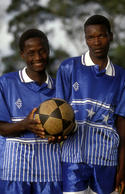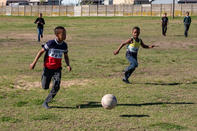Laduma!
Football (or soccer as we prefer to call it) is probably the biggest participation sport in the world, and is certainly one of the most watched, so it's not surprising that it has a very big following in South Africa and all over Africa.
The joyful blaring of the vuvuzela and the echoing sounds of adorning fans fill the various stadiums around South Africa every weekend as local soccer teams go head-to-head. The fanbase of SA soccer is quite amazing and the game is taken very seriously. It's hard not to get into the spirit of the game.
The sport in this country is headed by the South African Football Association (SAFA) with 2 main sections, one of which is a professional arm run by the National Soccer League where huge sponsorship is injected into the game via the Premier League, which has 16 professional teams countrywide.
Every town has a soccer club and in even the tiniest settlement, you will find a dusty field with makeshift goals where the local children play their hearts out.
History of SA Soccer

Soccer was introduced in South Africa during the late 19th century. The British, who colonised the country, brought the sport over, and British soldiers would play the game while off duty. Organised soccer was introduced in the form of racial segregation, so each race had their own association. During the apartheid years, the game was predominantly played nationally by white civilians, who played a series of matches against international teams from 1906 onwards.
In 1953, South Africa formed part of four African nations who gained access to the FIFA executive committee. The four nations formed the founded the Confederation of African Football in 1956, but SA was expelled from it in 1958 due to its segregation laws. The all-team joined FIFA in the same year, but was given an ultimatum in 1960 to either adhere to the association’s non-discriminatory regulations or be suspended. SA was ultimately suspended a year later, which was later lifted in 1963. 1976, after the Soweto uprisings, SA was formally expelled from FIFA until 1992 due to its apartheid policies.
After the demolition of the regime and the introduction of a democractic government, South Africa formed a new, multi-racial football association and the country was readmitted to FIFA. Since the 1990’s, SA has garnered a well-developed infrastructure of soccer. In 2010, the country hosted the FIFA World Cup, which led to an immense boost in tourism and the construction of numerous world-class stadiums.
National and Local Teams

The two national soccer teams of South Africa are Bafana Bafana (a Zulu term of endearment which means the boys, the boys) and the women’s team, Bayana Bayana. Both are controlled by the South African Football Association (SAFA).
Bafana Bafana have played various Africa Cup of Nations tournaments, winning once. They participated in the FIFA World Cup three times, and in 2010 player Siphiwe Tshabalala was the first person to score in the World Cup during the opening game against Mexico. The team's highest achievement was winning the Africa Cup of Nations in 1996.
Bayana Bayana has played at nine African Women's Championships, placing second at four occasions. They qualified for the FIFA Women's World Cup for the first time ever in 2019 in France.
Local soccer clubs from the different provinces are quite popular and most have a large fanbase. The most prominent clubs include Ajax Cape Town F.C., Orlando Pirates F.C., Kaizer Chiefs F.C. and Mamelodi Sundowns F.C.



 The biggest sporting event in the world was hosted in South Africa, and there could not have been a country more deserving, more prepared or...
The biggest sporting event in the world was hosted in South Africa, and there could not have been a country more deserving, more prepared or... he 2010 Soccer World Cup in South Africa left behind a legacy of world-class sporting facilities and infrastructure. Several stadiums underw...
he 2010 Soccer World Cup in South Africa left behind a legacy of world-class sporting facilities and infrastructure. Several stadiums underw...